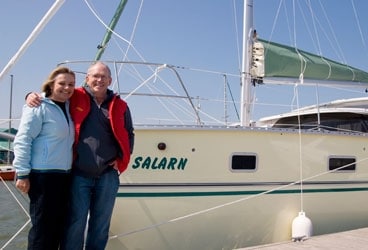
Chestnut 368
We were about to round the next headland, Cabo de Gata, on the coast of southern Spain. We had 15-knot winds on our bow when the breeze unexpectedly shifted 180 degrees and gusted up to near 40. Rain poured down, dousing us like water from a huge fire hose. Add to this a healthy dose of thunder and lightning and way too much sail set, and we felt as though we were in the spin cycle of a washing machine.
We hadn’t experienced a line squall while we’d been aboard Salarn, and once my wife, Sally, had managed to haul the mainsail down under the watchful eye of a sparrow who’d taken refuge in the saloon, we vowed that next time, we’d take such dark-looking weather systems a little more seriously.
To be honest, we hadn’t expected to find ourselves in such a predicament-or even at sea in the first place. But after my 37 years as a dentist, three grown children, and a summer night with a bottle of wine, Sally and I were sitting in a gazebo discussing what our retirement would look like. She suggested getting back into sailing, perhaps on something larger than a Laser, to cruise around Lake Ontario. I raised the ante: Why limit ourselves? Why not sail around the world? Sally said, “OK.”
It was during our first boat show, in the fall of 2006, that we saw and fell in love with an Antares 44 catamaran. Before we knew it, we committed to the boat-and then found that we were booked with sailing lessons for the coming season.
Our plan was to sail from Kingston, Ontario, to New York via the Erie Canal, then on to La Rochelle, France. Those plans quickly changed when Tropical Storm Cristobal chased us up to Halifax for an unscheduled visit with friends and family. A thick fog followed us the day we left Halifax, but it eventually cleared to make way for our first “training” storm, with winds of 25 to 30 knots. Admittedly, we were frightened, but we gained confidence in Salarn’s ability to weather the sea. This first storm prepared us for the larger winds that would follow.
We had some great firsts while crossing the Atlantic: playing with dolphins; whale sightings; and although I didn’t catch many fish, I did snag some seaweed and two large seabirds. Our first sight of land after 14 days at sea was Horta, in the Azores. Three and a half weeks after we left Halifax, we arrived at La Rochelle. Coming into one of the busiest marinas in France was an experience in itself.
We had just over two months to cruise from La Rochelle to Barcelona, in Spain, where we’d leave the boat for the winter. The first challenge was getting out of the crowded marina and across the infamous Bay of Biscay without hitting another boat. Fortunately, Biscay didn’t live up to its reputation, and we arrived safely three days later in Baiona, Spain. As we continued our cruise, we realized that traveling by water with the ability to tie up in the middle of historic towns is such a privilege and opportunity. We reached Viana do Castelo, Portugal, for what was supposed to be a quick overnight stop, but we couldn’t resist the charm and appeal of this ancient port, and our plans quickly changed once again. With a Portuguese dictionary in hand, we navigated the narrow cobbled streets, old fortifications, and beautiful churches.
As we sailed, our learning opportunities continued. The first time we anchored, we miscalculated the tides and ended up with mere inches below our keel. We found that it took several dives to clear away a fish net and ropes from our propeller. And we had a very exciting docking experience when trying to tie up against 20-knot gusts that pushed us away from the dock. Before we were finally secured, Sally managed to fall between the dock and Salarn, but she never dropped the line and only got her back and bum wet. After nearly hurting myself with laughter, I was able to rescue the pretty damsel in distress.
We still find it hard to grasp what we’ve accomplished in our first year. Cruising in a foreign land thousands of miles away from our home port may have been an extreme way to learn, but the knowledge and experience gained in this one season has given us confidence in our abilities and, perhaps more important, in the seaworthiness of our boat.
After leaving Salarn in Spain for the winter of 2009, the Chestnuts planned to sail for Greece.







